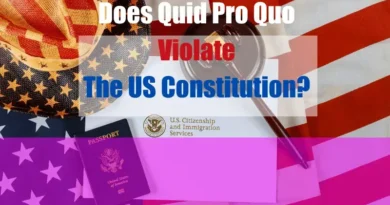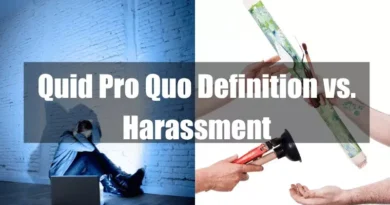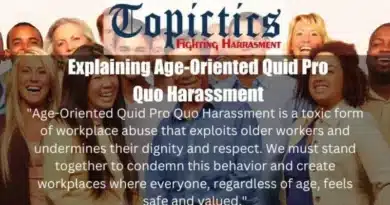Here’s an informational table that captures the key takeaways from the article:
| Aspect | Details |
|---|---|
| Can A Student Commit Quid Pro Quo Harassment? | Students can commit quid pro quo harassment by leveraging informal power or influence over peers. |
| Position of Power or Influence | Even without formal authority, students can exploit their social status or leadership roles for coercion. |
| Peer Relationships | Harassment can occur through social leverage, such as promises of acceptance or academic help. |
| Team Dynamics | Student leaders in clubs or sports teams may use their influence to demand sexual favors. |
| Reporting and Institutional Response | Institutions must have clear policies and procedures for addressing all forms of harassment, including student-to-student cases. |
| Examples of Harassment | Scenarios include trading academic help, social acceptance, protection from bullying, or club participation for sexual favors. |
| Legal and Policy Implications | Title IX mandates schools to address all forms of sexual harassment, including quid pro quo harassment by students. |
| Understanding Power Dynamics | Informal power structures and social hierarchies among students can facilitate quid pro quo harassment. |
| Institutional Responsibilities | Schools should develop comprehensive policies, provide training, and ensure prompt investigations and disciplinary actions. |
| Further Recommendations | Promote a culture of respect, empower students, regularly review policies, and build support networks. |
Let’s discuss in detail:
Quid pro quo harassment involves an individual in a position of authority demanding sexual favors in exchange for some benefit. This benefit could range from job security and promotions to favorable academic treatment. The term “quid pro quo” is Latin, meaning “this for that,” which aptly describes the nature of this harassment – an exchange where something is given in return for something else, specifically, sexual favors.
I. Can a Student Commit Quid Pro Quo Harassment?
In educational settings, quid pro quo harassment is often considered the domain of authority figures like teachers, professors, or administrators. However, students can also engage in this type of harassment under particular circumstances.
Key Points to Consider
1. Position of Power or Influence
Students typically do not have formal power over their peers, but they can hold significant influence in various situations. For instance, a senior student might offer protection, social inclusion, or academic help in exchange for sexual favors. This kind of influence can create an environment where quid pro quo student harassment becomes possible.
2. Peer Relationships
Harassment can occur between peers, especially when one student has some form of leverage over another. This leverage does not need to be formal authority. Still, it can come from social standing, access to certain resources, or other influential factors. For example, a popular student might promise social acceptance or inclusion in exchange for sexual favors.
3. Team Dynamics
Extracurricular activities such as sports teams, drama clubs, or student organizations often have hierarchical structures. A student in a leadership position within these groups might exploit their role to demand sexual favors. For example, a team captain could use their influence over team selection or participation to harass other students.
4. Reporting and Institutional Response
Educational institutions are responsible for addressing all forms of harassment, including quid pro quo student harassment. Schools must have robust policies to handle complaints, ensure a safe environment, and take disciplinary actions when necessary. These policies should clearly define harassment, outline procedures for reporting and investigating complaints, and specify disciplinary measures for those found guilty of harassment.
II. Examples of Student-to-Student Quid Pro Quo Harassment

Academic Help
A student offering to do homework or tutor another student in exchange for sexual favors. This scenario exploits the academic pressures and struggles that many students face, turning what should be a supportive gesture into a manipulative and harmful demand.
Social Acceptance
A student promising inclusion into a popular group or social circle in return for sexual activities. This form of harassment leverages the natural desire for social acceptance and belonging, using it as a tool for exploitation.
Protection from Bullying
A student offering protection from bullying or harassment by others in exchange for sexual favors. This situation preys on the fear and vulnerability of those who are already being mistreated, exacerbating their distress by adding another layer of exploitation.
Club or Team Participation
A student leader suggests that participation in a club or sports team is contingent on providing sexual favors. This scenario involves leveraging a position of influence within extracurricular activities to coerce other students into unwanted sexual activities.
III. Legal and Policy Implications
Title IX
Under Title IX of the Education Amendments of 1972, educational institutions are mandated to prevent and address all forms of sexual harassment, including quid pro quo harassment, regardless of whether it is perpetrated by students or staff. Title IX ensures that all students have the right to an education free from discrimination based on sex, including sexual harassment.
Institutional Policies
Schools should have clear policies that define harassment, outline procedures for reporting and investigating complaints, and specify disciplinary measures for those found guilty of harassment. These policies are essential in creating a safe and supportive educational environment. They must be regularly reviewed and updated to address new challenges and ensure they are effectively implemented.
While quid pro quo harassment is most commonly associated with authority figures, students can indeed commit this form of harassment. Institutions must recognize the potential for student-to-student harassment and have policies and procedures to address and prevent it.
By fostering a culture of respect and accountability, educational environments can work towards eradicating all forms of harassment.
IV. Understanding the Dynamics of Power and Influence Among Students

Informal Power Structures
Students can hold significant informal power over their peers in many educational settings. This power can stem from various sources, including social status, academic performance, or involvement in extracurricular activities. For example, a student who is highly regarded in a social or academic context may wield considerable influence, which can be abused to coerce others into providing sexual favors.
Social Hierarchies
Social hierarchies are prevalent in schools and universities. Students at the top of these hierarchies often can grant or deny social inclusion, which can be a powerful motivator for their peers.
This social leverage can be used to demand sexual favors in exchange for social acceptance, making it a form of quid pro quo harassment.
V. The Role of Educational Institutions in Addressing Harassment
Creating a Safe Environment
Educational institutions are critical in creating a safe environment for all students. This involves not only having policies in place but also ensuring that students are aware of these policies and how to report any incidents of harassment. Schools must provide training and resources to both staff and students to recognize and address harassment.
Support Systems
Schools should offer support systems for students who experience harassment. This includes counseling services, support groups, and other resources to help victims cope with the emotional and psychological impacts of harassment. Providing a supportive environment can encourage victims to come forward and report incidents.
VI. Detailed Examples of Student-to-Student Quid Pro Quo Harassment

Scenario 1: Academic Help
Imagine a senior student offering to help a struggling first-year student with homework. The freshman is under significant academic pressure and feels overwhelmed by their coursework. The senior student, recognizing this vulnerability, offers tutoring but suggests that the freshman must provide sexual favors in return. This scenario illustrates how academic pressures can be exploited to coerce students into unwanted sexual activities.
Scenario 2: Social Acceptance
Consider a popular student in an exclusive social group at school. The popular student approaches another student, eager to be accepted into this group, with an offer: they can join the group, but only if they provide sexual favors. This type of harassment leverages the natural desire for social belonging and uses it as a tool for exploitation.
Scenario 3: Protection from Bullying
In some cases, a student may be experiencing bullying or harassment from other peers. A student who is in a position to offer protection might demand sexual favors in exchange for their protection. This scenario preys on the fear and vulnerability of those who are already being mistreated, adding another layer of exploitation and harm.
Scenario 4: Club or Team Participation
A student leader of a sports team or club might suggest that participation is contingent on providing sexual favors. For example, a team captain could imply that only those who comply with their demands can participate in important events or receive significant roles. This situation involves leveraging a position of influence within extracurricular activities to coerce other students into unwanted sexual activities.
VII. Institutional Responsibilities and Response Strategies
Developing Comprehensive Policies
Institutions must develop comprehensive policies that clearly define what constitutes harassment and outline the procedures for reporting and addressing complaints. These policies should be communicated effectively to all students and staff, ensuring everyone knows their rights and responsibilities.
Training and Awareness Programs
Educational institutions should implement training and awareness programs to educate students and staff about harassment, including quid pro quo harassment. These programs should focus on recognizing the signs of harassment, understanding the reporting procedures, and knowing how to support victims.
Prompt and Fair Investigations
When a complaint is made, institutions must conduct prompt and fair investigations. This involves gathering evidence, interviewing witnesses, and ensuring that the rights of both the complainant and the accused are protected. A thorough investigation is crucial for determining the facts and taking appropriate action.
Disciplinary Actions
Institutions should have clear disciplinary actions for those found guilty of harassment. Depending on the severity of the harassment, these actions can range from warnings and suspension to expulsion.
Clear consequences help deter potential harassers and demonstrate the institution’s commitment to maintaining a safe environment.
VIII. Legal Framework and Title IX

Understanding Title IX
Title IX of the Education Amendments of 1972 is a federal law that prohibits sex-based discrimination in any education program or activity receiving federal financial assistance. This includes sexual harassment, which is recognized as a form of discrimination. Under Title IX, schools are required to take immediate and effective steps to address harassment and prevent its recurrence.
Compliance with Title IX
Schools must comply with Title IX with policies and procedures to handle harassment complaints. This includes appointing a Title IX coordinator to oversee compliance efforts and ensure that investigations are conducted properly. Compliance with Title IX is a legal requirement and a commitment to providing a safe and equitable educational environment.
Quid pro quo harassment is not limited to authority figures; students can also commit this form of harassment. Educational institutions must recognize the potential for student-to-student harassment and have policies and procedures to address and prevent it.
By creating a culture of respect and accountability, schools can work towards eradicating all forms of harassment. This involves developing comprehensive policies, providing training and support, and ensuring all complaints are handled promptly and fairly. In doing so, institutions can foster a safe and supportive environment where all students can thrive.
IX. Further Considerations and Recommendations

Promoting a Culture of Respect
Educational institutions should promote a culture of respect and inclusivity. This involves not only addressing harassment when it occurs but also taking proactive steps to prevent it. Schools can foster a respectful environment by promoting positive behaviors, encouraging open communication, and promptly addressing issues.
Empowering Students
It is crucial to empower students to speak out against harassment. This can be achieved through education and awareness programs informing students of their rights and available resources. Empowered students are more likely to report harassment and support their peers, contributing to a safer school environment.
Regular Review of Policies
Policies should be regularly reviewed and updated to reflect current best practices and address new challenges. This ensures that the institution’s handling of harassment remains effective and relevant. Regular reviews also allow for gathering feedback from students and staff, making the policies more comprehensive and inclusive.
Building a Support Network
Creating a network of support for students who experience harassment is vital. This includes providing access to counseling services, support groups, and other resources. A strong support network can help students cope with the emotional and psychological impacts of harassment and encourage them to come forward and report incidents.
X. Conclusion
Quid pro quo harassment by students is a serious issue that educational institutions must address. By understanding the dynamics of power and influence among students, developing comprehensive policies, and promoting a culture of respect and accountability, schools can create a safer and more supportive environment for all students. Institutions must recognize the potential for student-to-student harassment and take proactive steps to prevent and address it.
Through education, support, and effective policy implementation, schools can work towards eradicating all forms of harassment and ensuring a positive educational experience for everyone.









